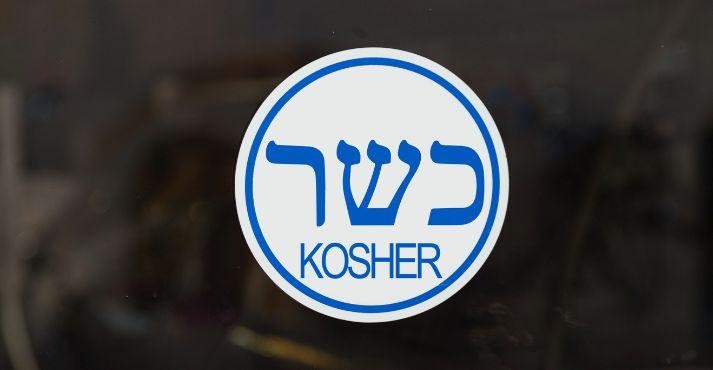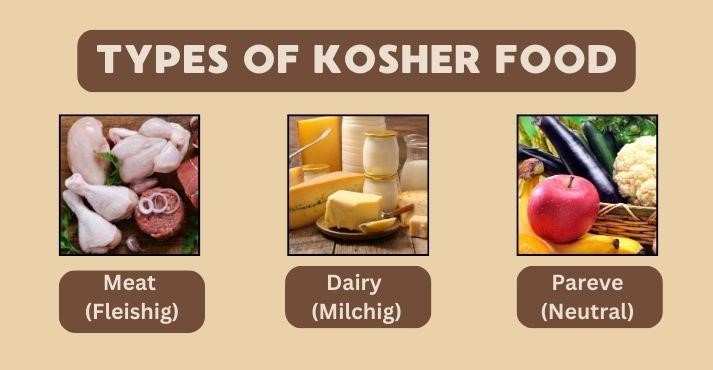Why is kosher food so important in certain cultures? Kosher food is a dietary system that follows the guidelines set forth by Jewish law, known as Kashrut. These rules, rooted in religious and cultural practices, govern what is allowed or forbidden for consumption.
Kosher food ensures the preparation, ingredients, and processes align with these religious requirements. But what exactly does it mean for food to be kosher, and why does it matter?
We will learn and understand kosher food and its fundamental principles and relevance to people observing dietary laws.
What Does Kosher Mean?

The word “kosher” comes from the Hebrew term “kasher,” which means “fit” or “proper.” When talking about food, kosher refers to items permitted to be eaten according to Jewish dietary laws or Kashrut.
These laws are derived from the Torah, the central religious text in Judaism, and have been followed by Jewish people for thousands of years. The rules of Kashrut are strict, specifying not only what types of food are allowed but also how they should be prepared and consumed.
Following kosher laws is about maintaining spiritual purity. It is not simply a set of health guidelines but a way of life that connects deeply with Jewish tradition and identity.
By observing these laws, Jewish individuals maintain a close connection to their faith and community, as kosher rules are central to many Jewish rituals, holidays, and daily meals.
Principles of Kosher Food
At the heart of kosher food are several key principles that define what can be eaten, how it is processed, and how it is prepared. These principles shape the kosher dietary system, ensuring that foods are safe and religiously permissible. Let’s dive into the core principles of kosher food.
1. Treif and Kosher Animals
One of the most basic principles of kosher food is distinguishing between kosher and non-kosher animals. Kosher animals meet specific criteria, such as having split hooves and chewing their cud. Examples of kosher animals include cows, goats, and sheep.
Non-kosher animals, referred to as treif, include pigs, camels, and horses. The Torah provides clear guidelines on which animals are permitted, which forms the foundation of kosher food.
Only fish with fins and scales are considered kosher. This means that shellfish such as shrimp, lobster, and crab are forbidden under kosher law.
For birds, kosher species include chicken, turkey, and ducks, while birds of prey, such as eagles or hawks, are not allowed.
2. Shechita
For an animal to be kosher, it’s not enough that the species is permitted under Kashrut; it must also be slaughtered in a specific way. The method of slaughter is called Shechita, and it involves a swift, humane cut to the throat of the animal.
A trained professional known as a shochet performs this act. The purpose of Shechita is to minimize the animal’s suffering and ensure that the blood drains quickly and efficiently.
In kosher law, consuming blood is forbidden, which is why removing as much blood as possible from the meat is a critical part of the kosher slaughtering process.
After the animal is slaughtered, the meat is salted to draw out any remaining blood further. This step is essential to making the meat fit for consumption under kosher food laws.
3. Milk and Meat Separation
A key principle of kosher food is the strict separation of meat and dairy products. According to the Torah, “You shall not boil a young goat in its mother’s milk,” which has been interpreted to mean that dairy and meat cannot be cooked, consumed, or served together.
This rule extends to all kitchen parts, from storing ingredients to using utensils and cookware. Many kosher households have two sets of dishes and utensils, one for meat and another for dairy, to ensure that the two do not come into contact.
Even small traces of dairy or meat contamination can render the food non-kosher. For example, if a dairy spoon is accidentally used in a meat dish, the dish may no longer be considered kosher.
The strict observance of these rules ensures that people can maintain the purity required by kosher food laws.
4. Treifnu
The concept of treifnu refers to foods that are not kosher and, therefore, forbidden. While most people think of meat and dairy when it comes to kosher laws, treifnu extends beyond these categories.
Non-kosher fish (such as shellfish), certain insects, and products containing non-kosher additives or preservatives also fall under treifnu.
Kosher laws cover not just the type of food but also the preparation process, so any contact with non-kosher elements can render the food unfit for consumption.
In the modern world, the food industry produces many complex processed foods, making it difficult to know whether a product is kosher. Kosher certification ensures that packaged goods meet the requirements of Kashrut.
Types of Kosher Food

Kosher food is typically divided into three main categories: meat, dairy, and pareve (neutral). Each category follows specific rules that dictate how the food can be prepared, served, and consumed.
1. Meat (Fleishig)
Kosher meat comes from animals that are allowed under Jewish law, such as cows, sheep, and goats, and that have been slaughtered following the method of Shechita.
Once the meat is slaughtered and prepared, it must not be consumed alongside dairy products. Meat must also be inspected for health issues or imperfections that render it non-kosher.
One critical element of keeping meat kosher is salting it to remove all traces of blood. Jewish law prohibits the consumption of blood, so this step is necessary to ensure that kosher meat is safe to eat.
Kosher meat includes muscle, organs, and certain fats, provided they meet kosher requirements.
2. Dairy (Milchig)
Kosher dairy products come from kosher animals such as cows, goats, and sheep. Dairy products, like cheese and milk, must also adhere to strict guidelines to be considered kosher.
Not only must the animals producing the dairy be kosher, but the process of producing the dairy must ensure that no non-kosher ingredients, such as rennet from non-kosher animals, are used.
Just as with meat, kosher certification is important for dairy products. Many commercial dairy items undergo certification to verify that they meet all kosher standards, including the separation from meat products during production. Mixing meat and dairy is strictly forbidden in kosher food laws.
3. Pareve (Neutral)
Pareve refers to neither meat nor dairy foods that can be consumed with either. Examples include fruits, vegetables, grains, and eggs.
This food category is considered neutral, but it plays a fundamental role in Jewish meal planning. It offers flexibility when preparing meals involving meat and dairy dishes.
While pareve foods are neutral, they still need to follow kosher rules. For instance, vegetables must be carefully checked for insects, which are considered non-kosher. Similarly, some processed foods labeled as pareve must have kosher certification to meet all dietary laws.
4. Beverages and Packaged Goods
Beverages like wine, juice, and soda can also be covered by kosher laws. For example, kosher wine must be produced under strict supervision to ensure that no non-kosher elements come into contact with the product. Certain fruits and processes are also required to make the beverage kosher.
Packaged goods, like cereals, snacks, and canned foods, often need kosher certification to verify that they meet kosher standards.
This certification ensures that none of the ingredients, additives, or preservatives used in the food come from non-kosher sources or have been contaminated during production.
Popular Kosher Dishes and Ingredients
Jewish cuisine offers a wide array of traditional kosher dishes that people worldwide enjoy. These dishes not only meet the dietary requirements of kosher food but also have significant cultural and historical importance.
Traditional Kosher Dishes
- Matzo Ball Soup: A soup made with dumplings formed from matzo meal, unleavened bread, served during Passover and other Jewish holidays. It’s a comfort food that holds special meaning in Jewish families.
- Gefilte Fish: A dish made from ground fish, typically served cold as an appetizer during holidays. It’s a classic part of Jewish holiday meals, especially for Passover.
- Challah: This braided bread is typically eaten on the Sabbath and during Jewish holidays. It’s made without dairy so it can be consumed with any meal, making it versatile in kosher meals.
Kosher Ingredients
Some common ingredients used in kosher food preparation include:
- Kosher Salt: A coarse salt that is used not only in cooking but also in the process of koshering meat.
- Matzo Meal: many traditional Jewish dishes use ground matzo during Passover.
- Specific Spices: Spices that have kosher certification to ensure they are free from non-kosher additives.
These ingredients play a key role in Jewish cooking, ensuring that meals remain delicious and compliant with kosher rules.
Kosher vs. Halal

While kosher and halal dietary laws are rooted in religious traditions, they have distinct rules and guidelines. Kosher food is governed by Jewish law, while halal food follows Islamic guidelines.
One of the primary differences is the handling of meat. Both require a specific slaughter process, but halal meat must be blessed in the name of Allah before slaughter.
Additionally, halal permits the consumption of certain foods forbidden under kosher law, such as shrimp.
Conversely, kosher laws require stricter supervision of food preparation, including the separation of meat and dairy.
Common Kosher Food Practices
Passover Dietary Restrictions
Take a trip through the dietary rules of Passover, an important Jewish festival. Learn about the unique practices followed during this time.
Passover Dietary Restrictions: Passover, a sacred Jewish festival, brings with it specific dietary guidelines. During this time, leavened products (chametz) are strictly avoided, symbolizing the removal of pride and arrogance. Instead, unleavened matzah takes center stage as a staple in Passover meals.

Matzah Significance: Unleavened matzah, a type of flatbread, holds deep symbolism during Passover. Its humble and unadorned nature aligns with the essence of the festival, fostering a sense of humility and connection to the historical narrative of the Jewish people.
Celebrating with Unleavened Foods: Passover dietary practices celebrate the essence of unleavened foods, particularly matzah passover tradition, which becomes a central element in various dishes during this festival. Understanding and respecting these dietary restrictions contribute to the meaningful observance of Passover.
Conclusion
In conclusion, kosher food is more than just a set of dietary rules; it’s a way of life for those who observe it. From the distinction between kosher and non-kosher animals to the thorough preparation processes, the laws of Kashrut guide every aspect of what is considered kosher.
Kosher certification ensures that processed foods meet these standards, allowing people to consume items that align with their faith confidently.
Whether it’s the careful separation of meat and dairy or the humane slaughtering practices of Shechita, kosher laws reflect both religious devotion and ethical food practices.
By understanding what is kosher food, we gain insight into a cultural and religious system that has sustained Jewish communities for ages.












